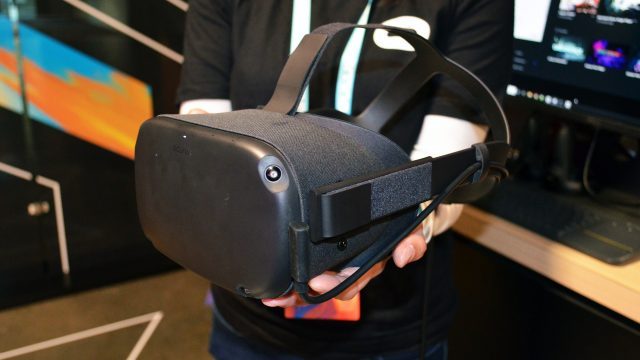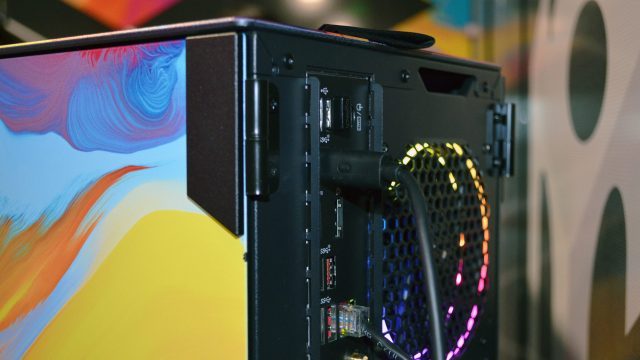
Announced yesterday, Oculus Link will allow Quest to play Rift games by connecting to any VR-capable PC. In our hands-on at Oculus Connect, the feature really does seem to deliver an experience that feels like a native PC VR headset.
At launch, Oculus Quest only worked with its own separate library of content powered by the headset’s on-board mobile hardware. That meant that even if you had a VR-ready PC (as many PC gamers these days do), you couldn’t play any games from the Oculus PC library, which includes some of VR’s best games.
That’s going to change in November with Oculus Link, a feature which opens up the Oculus PC library to the headset by plugging Quest into a PC via a USB 3 cable. Oculus has said that any USB 3 cable that meets spec will work, but as it’s hard to find one that meets bandwidth and power requirements at a length that would be suitable for room-scale PC usage; they’re planning to release their own “premium” USB 3 cable which they can be certain checks all the right boxes. The cable will reportedly cost $79.

I got to try Oculus Link with the premium cable at Connect this week, and though I didn’t get to pick my own content (which means I didn’t get to look at stress-test scenarios), my initial impressions are really quite positive.
With Quest plugged into a VR-ready PC and running Asgard’s Wrath, it really felt like a native PC VR headset. There was no noticeable increase in head tracking latency during my time playing, nor could I detect any on the controllers (though I’ll withhold final judgement until I get to test the system with something that’s more latency sensitive, like Beat Saber).
Visually, the image felt smooth with no stuttering or obvious compression artifacts, nor significant muddying of dense textures (something you often seen with attempts at wireless VR over Wi-Fi). The edges of geometry felt sharp and maintained strong stereoscopy.
At the conference this week, Oculus explained that they’re doing a sort of peripheral compression where the edges of the frame are compressed while the center remains high fidelity—had I not heard that direct from them, I certainly wouldn’t have noticed from my demo alone, as any compression artifacts that might have been in the periphery were hidden under the peripheral blur of the lenses anyway.

The only thing that caught my eye visually was the moving ocean water in Asgard’s Wrath looking granier than I would have expected. Unfortunately, without a Rift S on hand to test with, I couldn’t discern if this was simply a janky water shader (ie: just part of the pre-released game) or a consequence of the compression needed to make Oculus Link work. Indeed, small, high detail, low contrast visuals (like waves at a distance) are often worse-case scenarios for compression.
I’ll be patiently waiting to get Oculus Link into my own hands so I can specifically test against those challenging compression scenarios; so far, however, the visual experience with Oculus Link was head-and-shoulders above any Wi-Fi-based streaming solution that I’ve seen to date.
Unfortunately Oculus didn’t want to answer too many questions about Oculus Link, but did tell us that users can expect that it will enable Quest to act effectively identical to a Rift headset, including access to Dash, Home, etc.
However, we were also told that Oculus Link will allow Quest to play “most” Rift content, but not “all.” They didn’t explain why all apps wouldn’t work, though my gut tells me that there could be some apps that use novel rendering that won’t work with Oculus Link’s unique compression pipeline, or perhaps they’re covering their bases on some other technical edge-cases. They also added that developers could opt out of having their Rift apps work with Quest via Oculus Link if they so choose.
While I didn’t get a direct answer on whether or not Quest could potentially work with SteamVR, signs point to ‘probably’, as Oculus said the PC sees Quest pretty much like any other Rift headset. Rift apps won’t need to be modified in order to work with Oculus Link, which further suggests that SteamVR compatibility should be possible as long as Oculus doesn’t actively try to block it.

The company confirmed that the Oculus Link connection is not VirtualLink, which means it can plug into any USB 3 port, whether that be with a USB-A or USB-C connector on the PC side.
Additionally, plugging into a USB 3 port directly on the GPU versus one on the motherboard makes no difference, we were told, the rendering tech is the same either way. In fact, in my demo at the show, Quest was plugged into the PC’s motherboard. Further, using Oculus’ premium cable doesn’t change anything about rendering or quality; any other USB 3 cable will work just as well, so long as it’s up to spec.
The post Hands-on: Oculus Link Makes Quest Feel Like a Native PC VR Headset appeared first on Road to VR.
from Road to VR https://ift.tt/2m5Flzw
via IFTTT
No comments:
Post a Comment